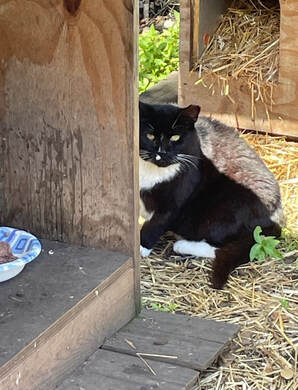 A “working cat” refers to a feral cat that is cared for (fed, sheltered, provided with medical care) by someone in exchange for the cat’s natural brand of pest control. Working Cats Programs grew out of TNR programs to provide the best option for unsocialized cats who had been trapped and sterilized but could not be returned to their original locations due to any number of reasons, such as the area being or having become unsafe for a cat to live. In such situations, rescues will hold onto the cats and put them up for adoption. These cats are not suited to be typical pets that live indoors and are handled often, but the people who adopt them are looking more for a partner than a pet. Alley Cat Rescue has operated a Working Cats Program as a last resort for feral cats who could not stay in their outdoor homes. To date, we have helped 4,500 feral and semi-feral cats in seven states through our Working Cats Program. In one case, when the authorities of Riverside State Park refused to allow the 10 colonies living there to remain on the land, ACR relocated them as working cats. Although relocation is not our preference for any cat, in some situations such as this one there are no safe alternatives. Over time, we have been happy to see more independent Working Cats Programs forming and county and city Working Cat Programs popping up around the country! One well-publicised program in Chicago has released 1,000 cats throughout the city to control a serious rat problem. Similar programs have already proven successful in Philadelphia, Washington D.C., and New York City. A list of Working Cats programs by state can be found at saveacat.org/shelters-with-working-cat-programs.html.
2 Comments
Alley Cat Rescue, Inc. (ACR) has completed a wide-spread online “Community Cat” survey of TNR groups and colony caretakers that shows a remarkable increase in TNR practices from 2012 to 2019. Survey data shows that the total number of community cats sterilized annually by respondents increased from 45,000 in 2012 to 62,000 in the most recent survey, which is an increase of about 4% per respondent.
The survey results have been analyzed by Animals 24-7, a nonprofit, independent online investigative newspaper and information service. ACR’s 2019 data, combined with data from their earlier national surveys done in 2017 and 2012, along with data from Animals 24-7’s 1992 and 1996 national surveys, reveal a “48% decline in kitten births in monitored neuter/return colonies during the first years that neuter/return was practiced, followed by a long plateau, during which the kitten birth rate edged down only 4% more in the next 16 years, probably due to limited resources” (Animals 24-7). That meant the decline in kitten births from 1992 to 2012 was 52%. However, ACR’s survey data spanning the years of 2012 to 2019 show a significant revitalization of TNR; between 2012 to 2017, kitten births dropped 72% and between 2017 and 2019, they had dropped by 77%. ACR’s most recent survey also reveals that extermination of colony cats is not an effective means of shrinking nor getting rid of colonies. Survey respondents who reported that animal control agencies had exterminated feral colonies in there area also reported that “39% were re-occupied by feral cats within less than a month; 71% within three months; 80% within five months; and 84% within six months” (Animals 24-7). 81% of ACR 2019 survey respondents reported cooperation with their TNR efforts from local animal control agencies and 37.5% reported actually receiving assistance from local animal control agencies. This reveals that government animal control is recognizing the importance of TNR. Data analysis source: https://www.animals24-7.org/2021/04/24/tnr-boomed-before-covid-19-hit-alley-cat-rescue-survey-shows/ |
Details
AuthorAlley Cat Rescue is leading in the way in promoting humane and compassionate care for ALL cats. Archives
June 2024
Categories
All
|
 RSS Feed
RSS Feed